Shy No More: MB&F LM1 Silberstein
I hadn’t seen my old friend Alain Silberstein in quite a while. Years, in fact.
So I was particularly happy to have had the opportunity to spend some time with him during Baselworld 2016 and discuss his latest project, the MB&F Legacy Machine Silberstein.
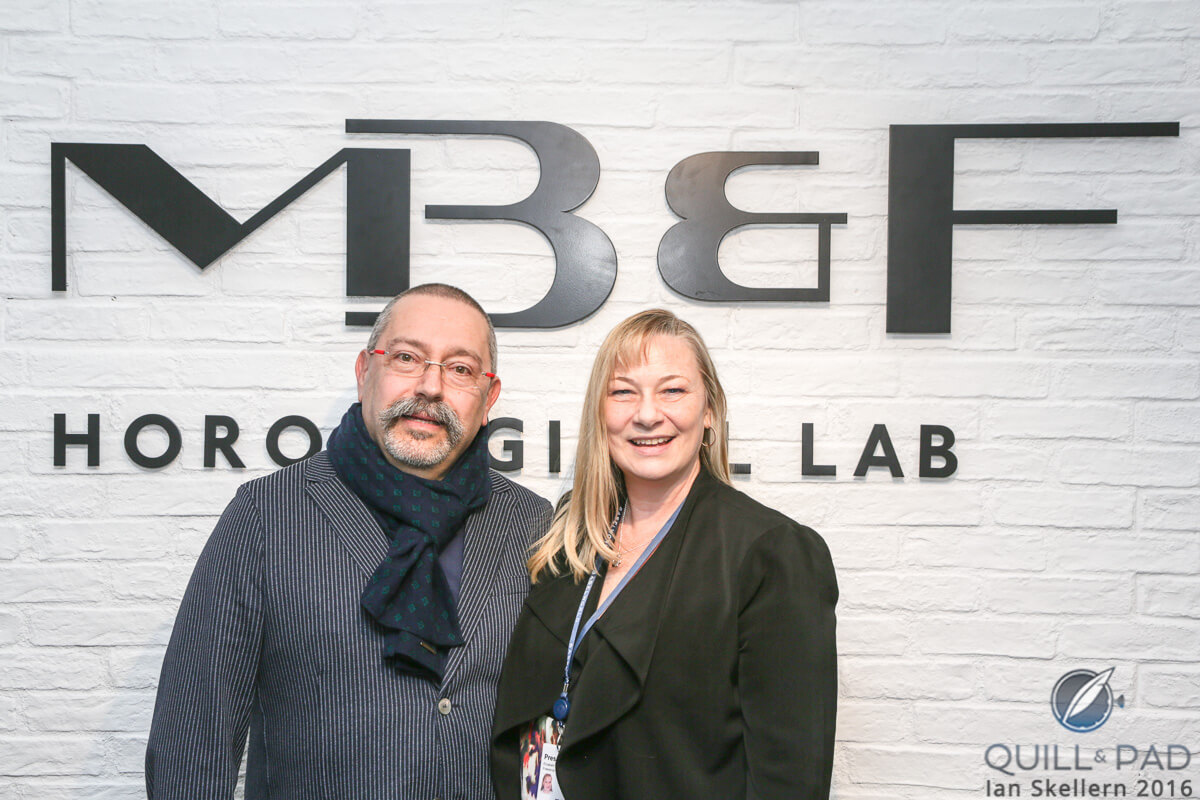
Alain Silberstein and Elizabeth Doerr at Baselworld 2016
But before I launch into that, I’d like to veer off on a different subject, one that is related and one that occurred to me as I was discussing with Silberstein and MB&F’s Maximilian Büsser how such artistic collaborations work.
I had asked Silberstein if he would ever have considered giving any of his own watches to another artist to play with and modify the design.
“No way,” was the reply. And I knew it would be. After all, creators tend to be very sure of themselves. And there is another thing that binds them: the need to create their own art.
So how is it that an artist like Büsser appears so laissez–faire about not only allowing others to redesign his “babies” but actually encourages and promotes it? Was the collaborative process as easy for Büsser as he made it look?
Not surprisingly, the answer was no.
MB&F’s Performance Art: not so easy
“When I started the MB&F creative trek, I had a lot of anger,” Büsser reminded me. “I needed to create what I believed in, even if there was no commercial future. Creatively, it was very much me against the world . . . and I would not let anyone – except Eric Giroud – work with me on any of my pieces.” Giroud, of course, is the independent designer that most brands turn to when they are looking for excellent, specialized watch design or even just good advice.
“But after a few years, pleasure started taking over from anger, and I imagined it would be interesting to have a creator I admire rework a piece of ours,” Büsser continued.
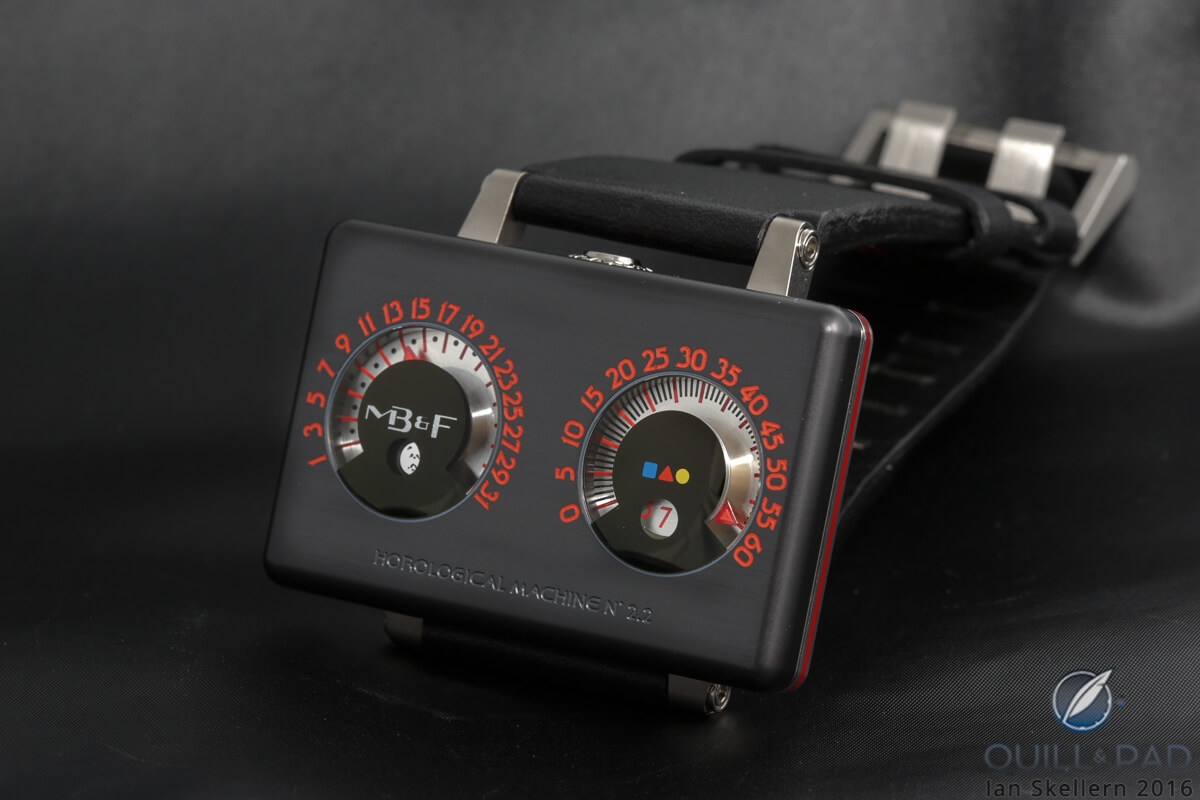
MB&F HM2.2 Black Box
Silberstein was the first artist that Büsser commissioned to rework one of his existing timepieces, Horological Machine No.2. “Back in 2009 . . . and I told him to enjoy himself with our HM2,” Büsser remembers.
Büsser first spotted Silberstein’s work more than 20 years ago, while on the highway passing a BMW Z1 whose windows were down, revealing the driver’s giant black chronograph. The look and size of that watch – years ahead of its time – was what kept Büsser engaged enough to keep a close eye on Silberstein over the ensuing years.
“Every year at Baselworld, since 1992, I would run to see what he had come up with,” Büsser remembers. “Reworking the basics of Bauhaus design, Alain managed to amaze me with incredible, innovative ideas for more than two decades.”
Büsser finally met Silberstein personally in 2007. “During that first dinner, I pitched him the idea of redesigning one of my pieces. He seemed sincerely surprised and actually accepted.” That piece became the MB&F HM2.2 Black Box of 2010, an eight-piece limited edition of the HM2 introduced in 2008.
HM2.2 Black Box
“I had imagined he would ‘only’ add his graphic design to the dial and hands, I suppose,” Büsser continues. “Not redesign the whole case. I was quite shocked when he came up with the Black Box design.”
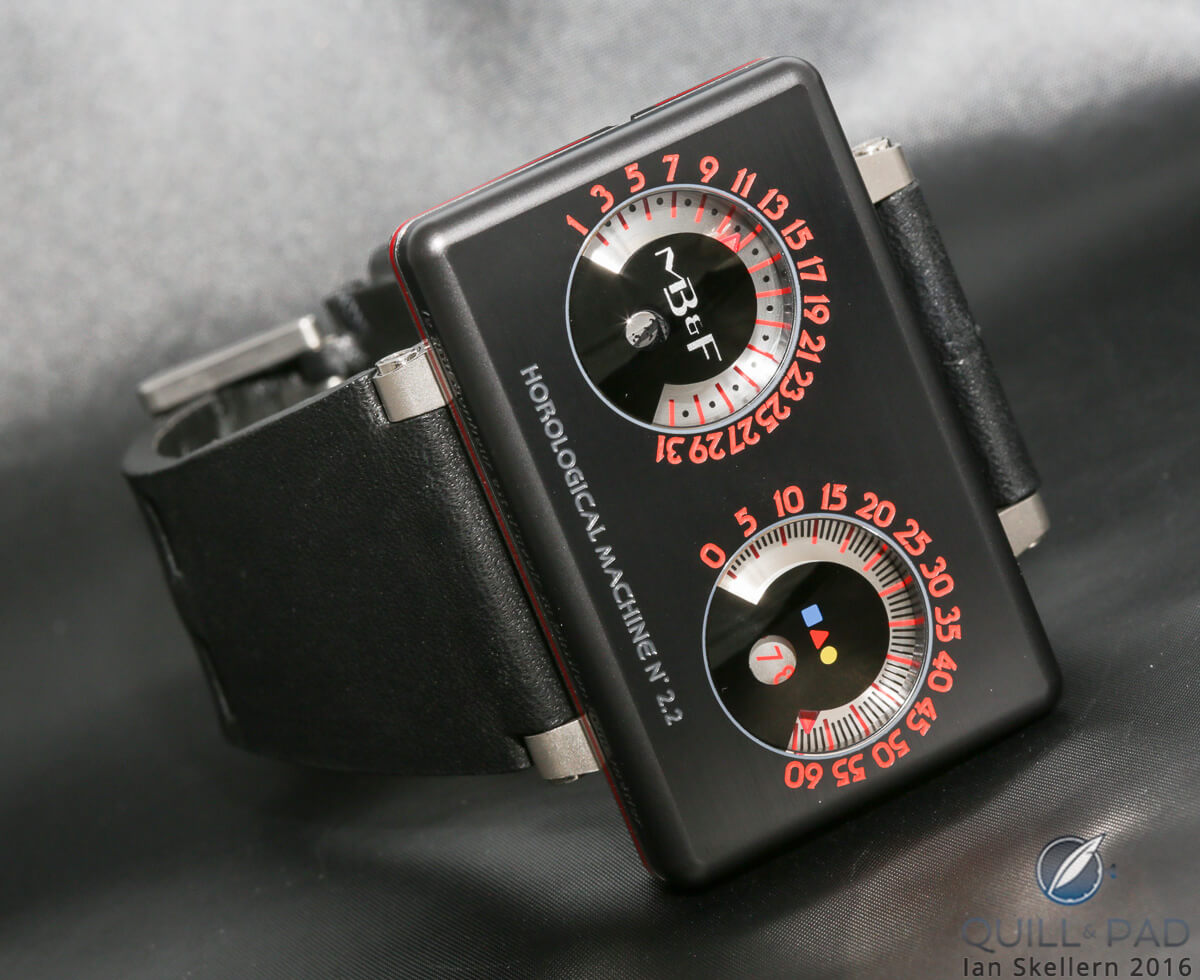
MB&F HM2.2 Black Box by Alain Silberstein was the first of the brand’s Performance Art pieces
MB&F’s automatic HM2 featured the world’s first mechanical movement combining an instantaneous jumping hour, concentric retrograde minutes, retrograde date, and a bi-hemisphere moon phase. But more than that, with its large, rectangular case the look of the HM2 was surprising. At that point in time, Büsser was sure it was the most complex watch case in history.
After Silberstein had done his magic the HM2.2 case retained its twin porthole dials and powerful profile with flying buttress-style lugs. But the original’s science fiction look had given way to something more whimsical. It definitely had a personality all its own.
Silberstein re-conceived the rectangular case as a solid block of titanium coated with an exclusive PVD containing silicon over the original steel substructure of HM2. This multi-layered construction provides a feel of power despite the seeming simplicity, probably in great part thanks to the intense black of this interesting coating.
“Many people like you, Elizabeth, were expecting to find something more colorful here,” Silberstein remembers. “In fact I agree with you, sometimes I feel at ease with colorful things, and other times I need to relax on a more black matte finish. Color is like another value, too. First there is a shape, a pure line, a design, an idea.”
Even technical elements become part of the design: the water resistant gasket sealing the upper and lower case sections plays double duty as an almost hesitant stripe of red around the case band echoing the color of the markings on the twin dials.
“I waited three days before coming back to him,” remembers Büsser. “He was actually waiting for an answer and wondering why I was not giving him feedback. After three days, I realized I had to let go and allow him do what he wanted. If you invite a creator to work with you, it cannot be to clip his wings.”
“And so the first performance art piece was created, a piece which neither of us co-creators would ever have created alone,” Büsser insists. “Then we did the JwlryMachine with Boucheron and the MoonMachine with Stepan Sarpaneva. Each time it was fantastic because you see a piece you have created morph into something different.”
“I suppose it is like having a child: there is part of the father and part of the mother. Just having clones of oneself can be a little boring,” Büsser insists.
I couldn’t help asking how Büsser feels about his performance art pieces now.
“I could not live without them!” came the relatively unexpected yet instantaneous answer. “They open my creative horizons, they enrich my soul, they allow me to work with people I admire, they make me smile, they give me pride, and they help me write my legacy, which is one of sharing and helping others.”
Legacy Machine 1
“Alain has contributed so much to the design segment of our industry and I feel he has by far not been awarded the kudos he has deserved,” says Büsser.
I agree wholeheartedly, by the way, so without further preamble I’d like to present the latest collaboration between these two: LM1 Silberstein, which is based on Legacy Machine 1.
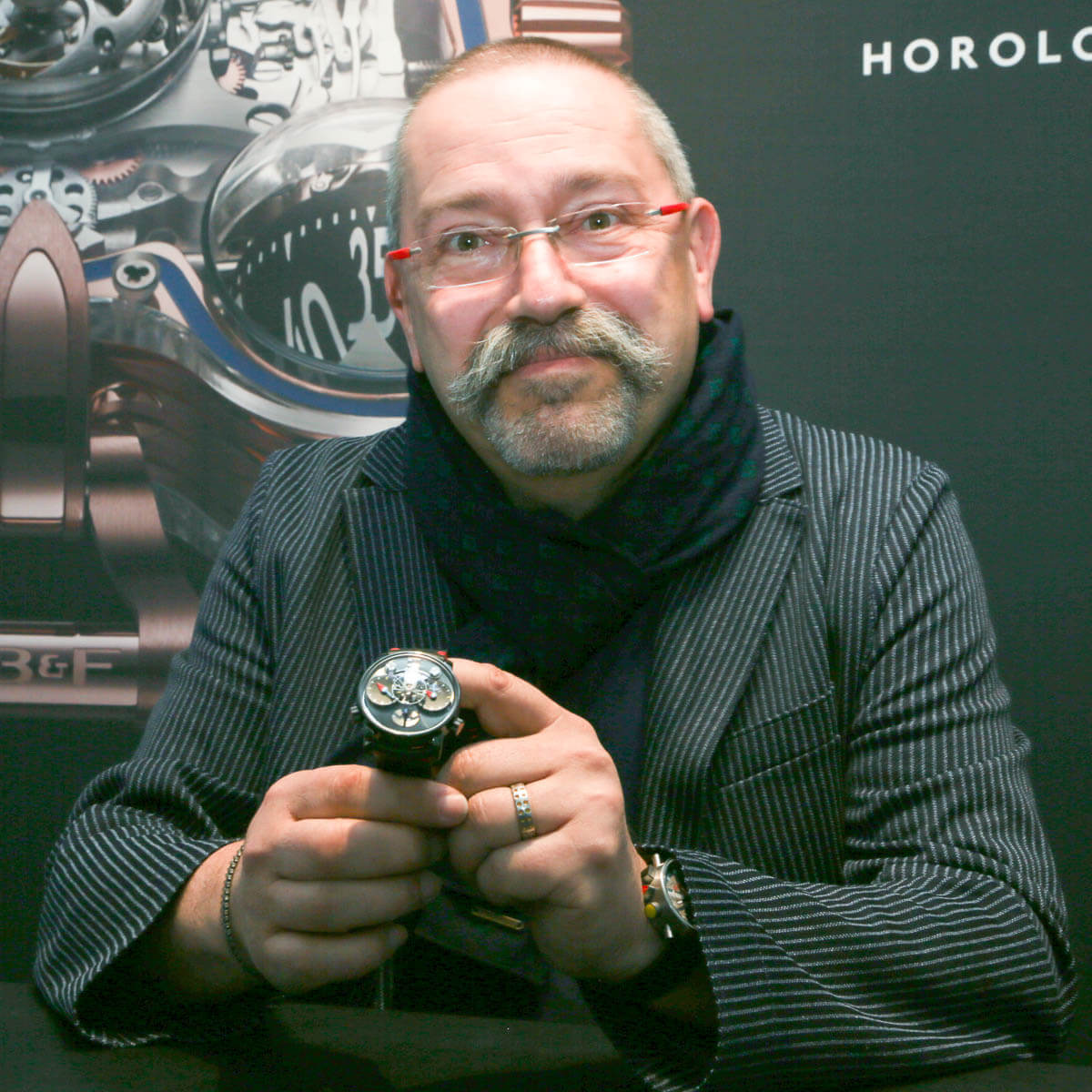
Alain Silberstein with LM1 Silberstein for MB&F
Introduced in late 2011, Legacy Machine opened up a second more “traditional” family of wristwatches for MB&F alongside the previous Horological Machines, which can be described as a second way of seeing a three-dimensional machine à la MB&F.
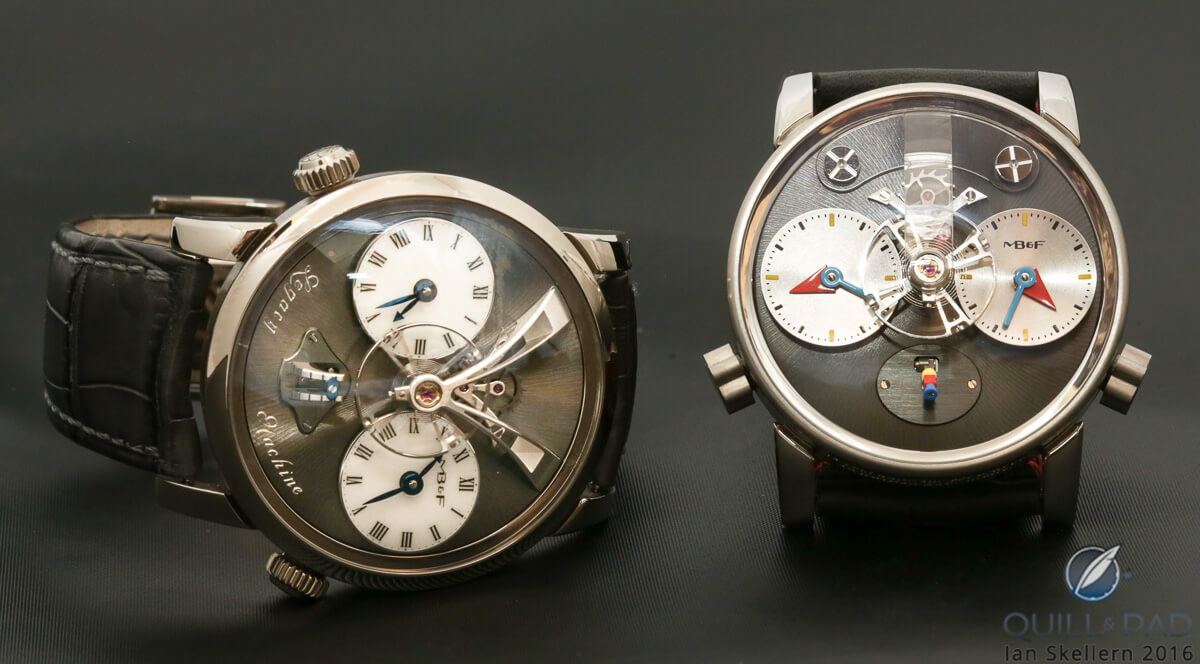
MB&F LM1 (left) and LM1 Silberstein
Büsser’s inspiration was the nineteenth century, a time he terms “the golden age” of watchmaking. The look of LM1 is dominated by a large 14 mm balance wheel floating between two subdials, each of which displays its own time zone and can be set – both hours and minutes – completely independently of the other using its dedicated crown. Boasting 45 hours of power from a single spring barrel, LM1 is housed in a complicated case comprising 65 individual parts.
When Büsser launched LM1, he described it as his first classic watch; its codes all originate in the traditional side of Swiss watchmaking, including the movement developed for MB&F by Jean-François Mojon and his team at Chronode according to Büsser’s sketches.
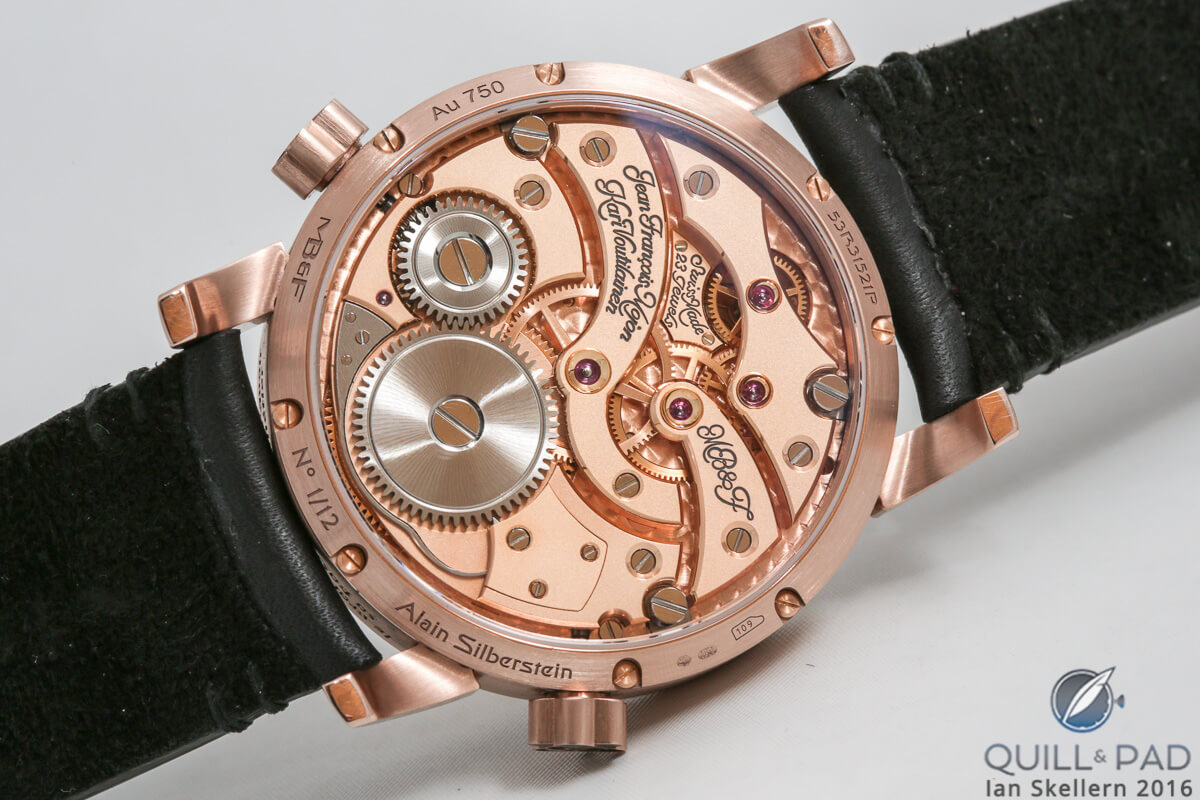
View from the back of the MB&F LM1 Silberstein in red gold
Independent watchmaker Kari Voutilainen assumed responsibility for the historical accuracy of the style and finishing of LM1’s movement, which was in no way an easy task with such an unconventional balance element on show.
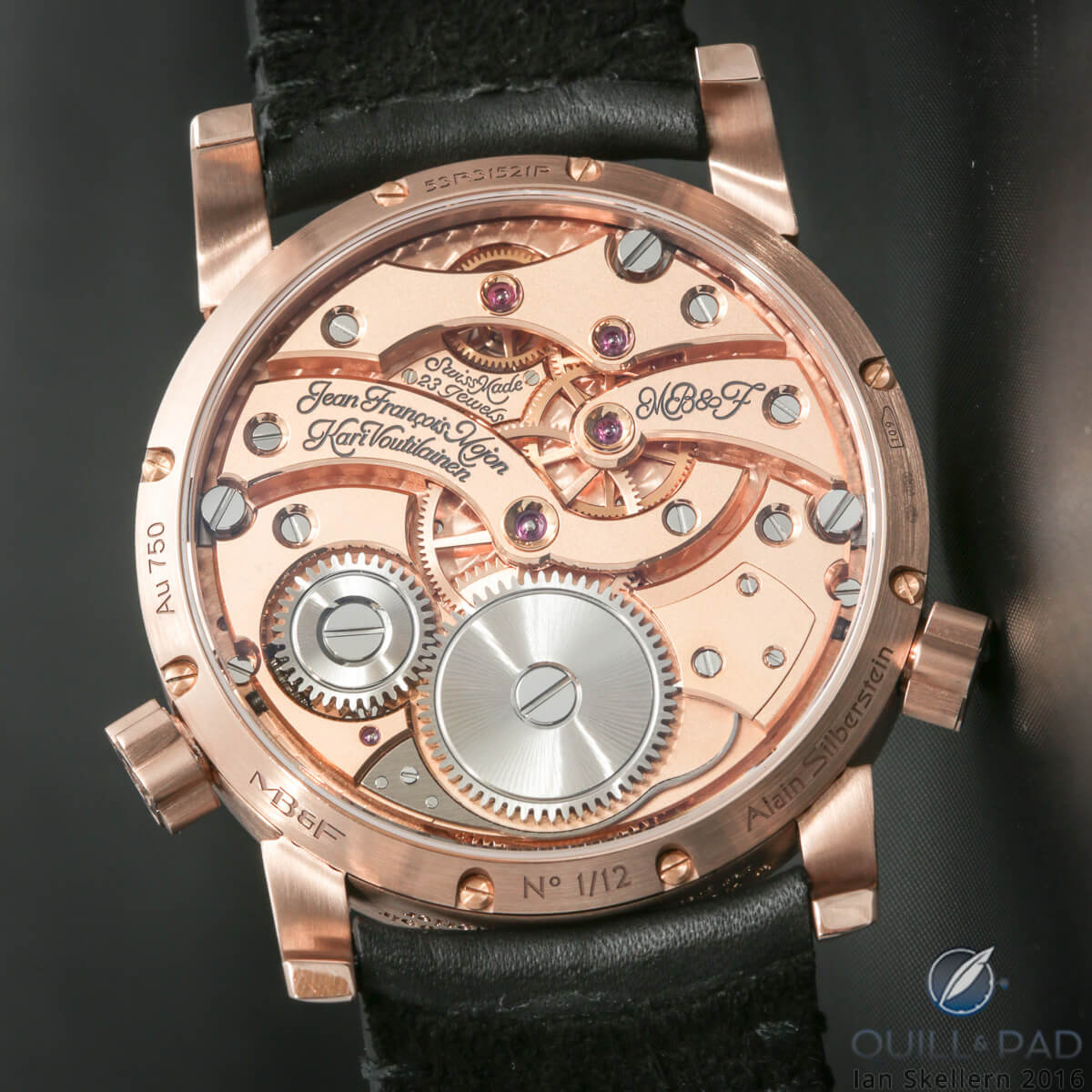
View through the display back of the MB&F LM1 Silberstein
Silberstein style
Despite the dark look and feel of HM 2.2, most watch aficionados know that Silberstein is usually quite enamored of primary colors and basic geometric shapes.
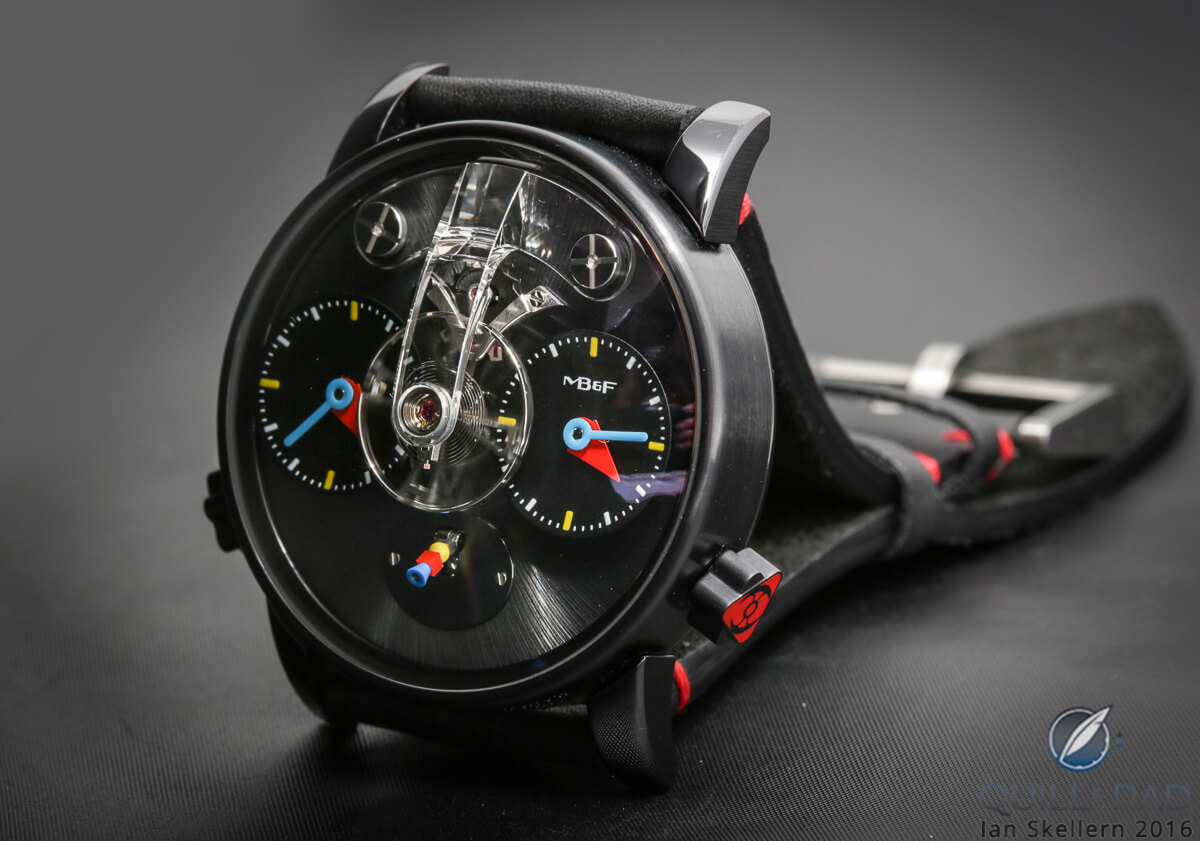
A close look at the dial side of the MB&F LM1 Silberstein in blackened titanium
When I asked him about his watches for MB&F, the French designer grinned beneath his ever-present mustache and replied, “This one is definitely more my style.”
Upon seeing LM1, Silberstein knew right away which two elements would make all the difference for him,. “When I saw LM1 for the very first time with its round subdials, I didn’t understand why they were convex rather than concave,” he explained.
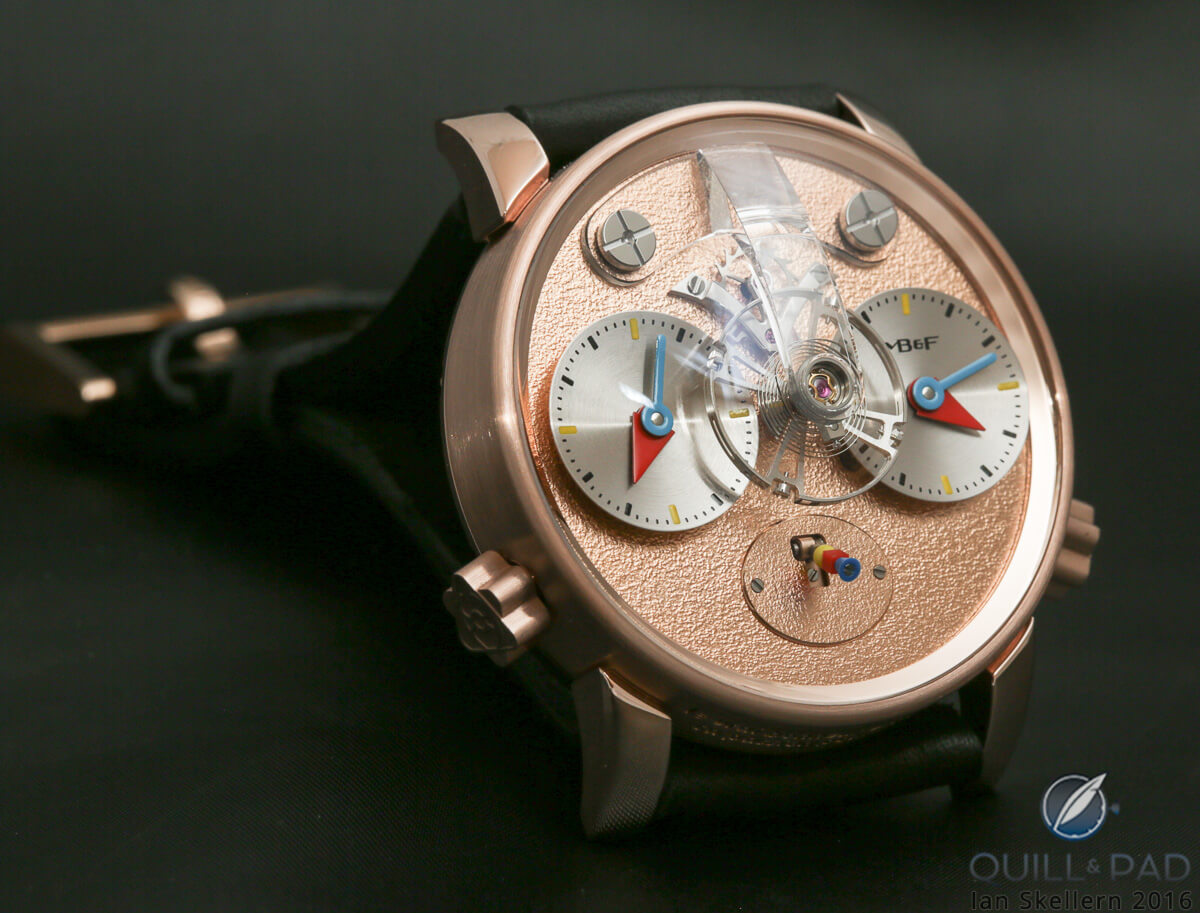
A look dial side of the MB&F LM1 Silberstein in red gold with frosted “dial”
The energy created by the convex sapphire crystal dome protecting the dial should be received by something of the opposite shape according to him. “To move the energy properly.”
Therefore, the first change was the subtle transformation of the subdials’ direction of curvature, turning them into little satellite dishes. The two time zone indicators, now concave rather than convex, attract and welcome time (from the universe) into the movement of the LM1 Silberstein.
But it was the second change that has practically made this Legacy Machine into a whole new watch: the “removal” of the visible bridge on the dial to make the escapement really fly.
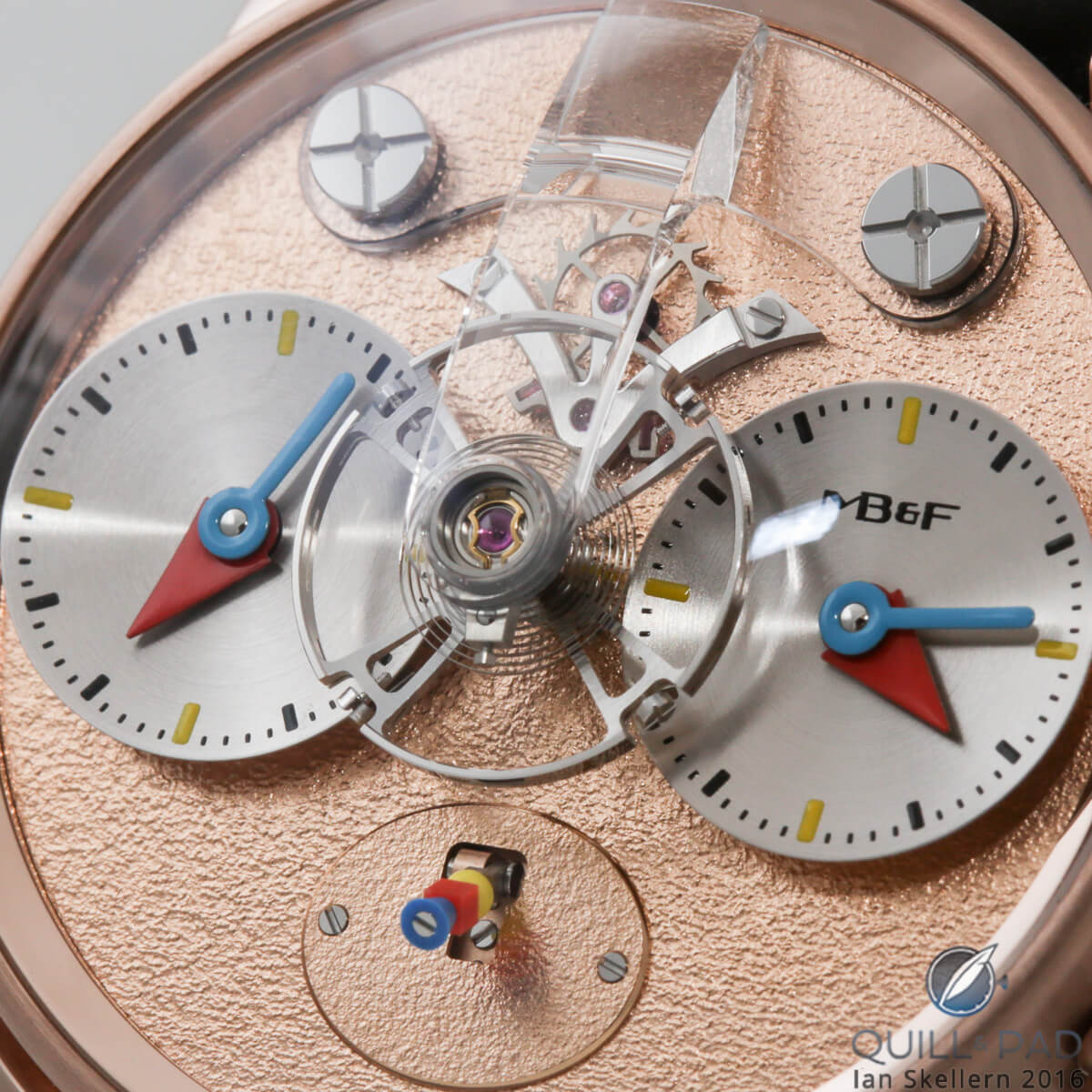
A close look at the dial side of the MB&F LM1 Silberstein in red gold with frosted “dial” (which is actually the movement’s top plate): note the sapphire crystal bridge holding the balance in place
Okay, so it’s not actually “removed.” But figuring out how to make this critical component both there and not there took about two years of research and development. After first looking to minimize the size of the existing metal bridge, Silberstein suggested making it out of a material that both designers adore: sapphire crystal.
Now the right proportion, supplier, and manufacturing method were all that was needed.
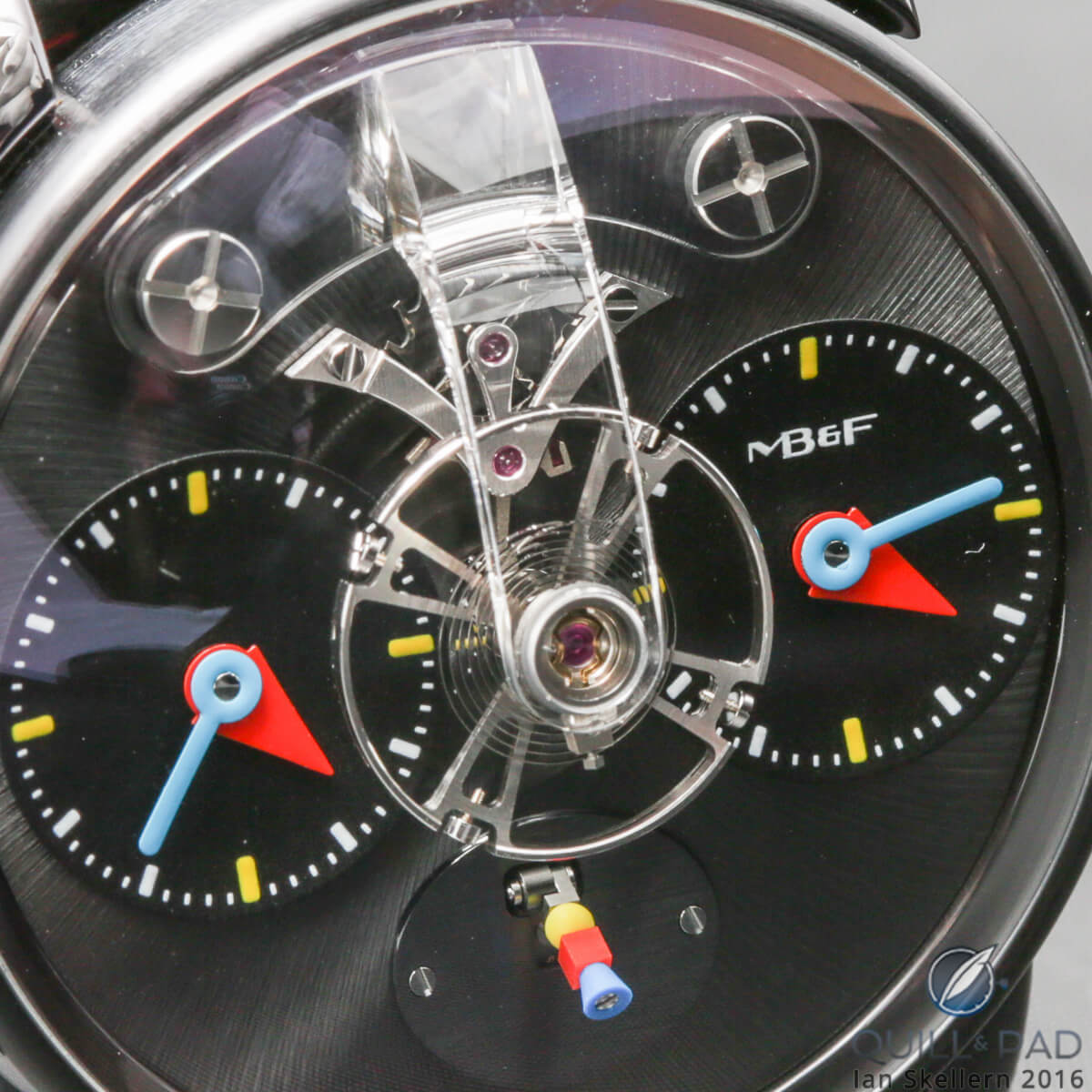
A close look at the dial side of the MB&F LM1 Silberstein in blackened titanium
“The result is amazing!” says Silberstein. “First, MB&F in conjunction with Jean-François Mojon imagined this classic balance on top of the movement. But I think we went to the end of what you could do to achieve something that is completely flying.”
The collaborative aspect
Fans of the designer will in no way be disappointed with the bright hues and geometric shapes they find on LM1 Silberstein, either: this timepiece is full of Silberstein’s forms (cone, cube, and sphere) and colors (red, blue, and yellow).

A close look at the dial side of the MB&F LM1 Silberstein in blackened titanium
The power reserve indicator is even a miniscule sculpture incorporating all of the above-mentioned elements.
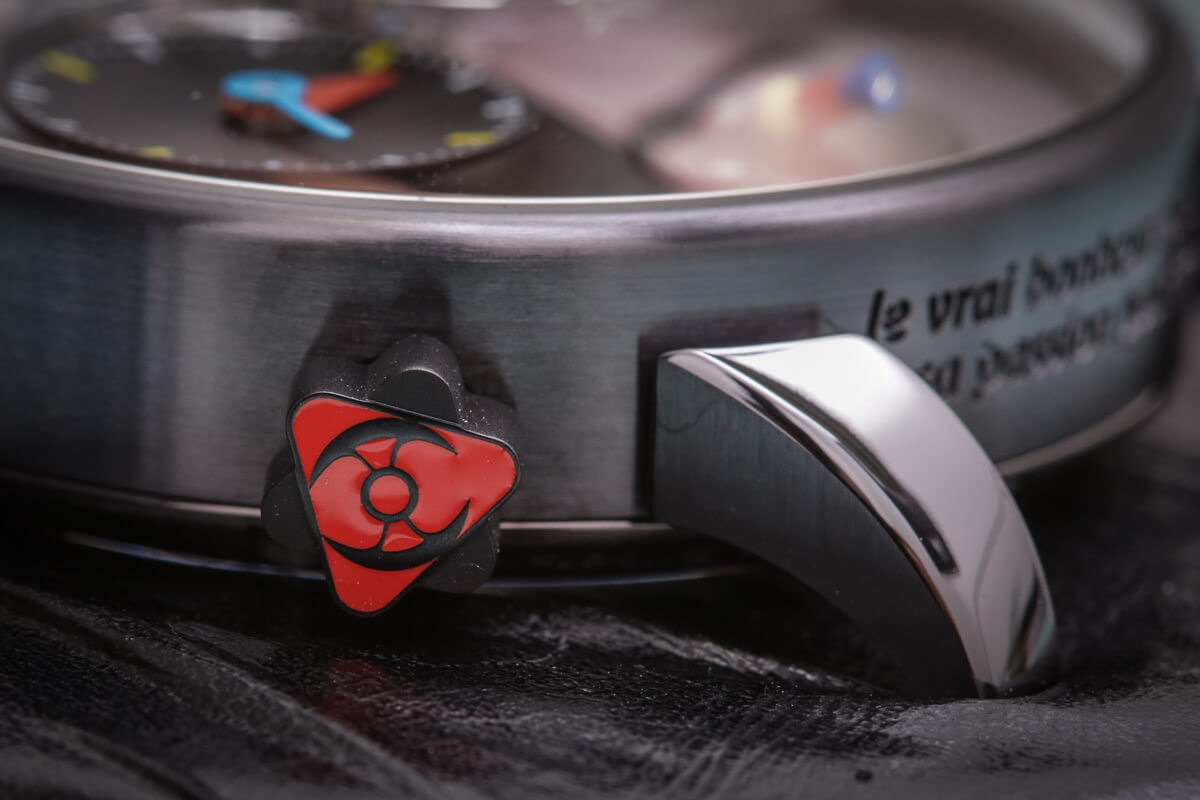
Even the crowns of LM1 Silberstein blend the worlds of both creators: a Silberstein triangle and primary red color with MB&F’s battle-axe icon
This Performance Art piece is heavy on collaborative design aspects, a fact that is perfectly represented by the crowns: the shapes and colors found here are pure Silberstein, while the battle-axe logo represents MB&F.
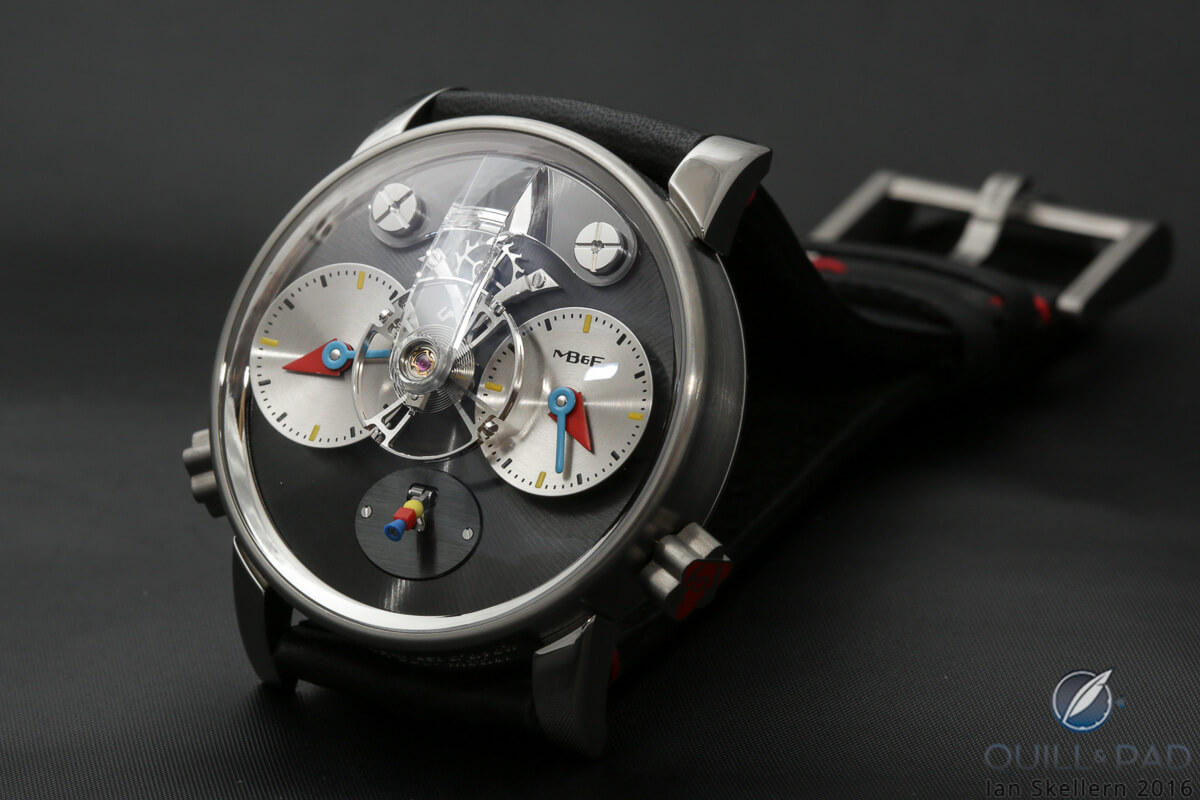
MB&F LM1 Silberstein in titanium
In case you were wondering why MB&F chose the Legacy Machine 1 to collaborate on, Silberstein revealed the answer to that too.
“The reason he asked me was because I made comments [when I first saw the original LM1] that resonated with Max regarding the shape of the two dials. When it’s your baby, sometimes you don’t look at it the same way. And sometimes an outsider does.”

MB&F LM1 Silberstein in blackened titanium
In other words, at times a tweak or implementing a different thought pattern is much more obvious to an outsider than to a creator.
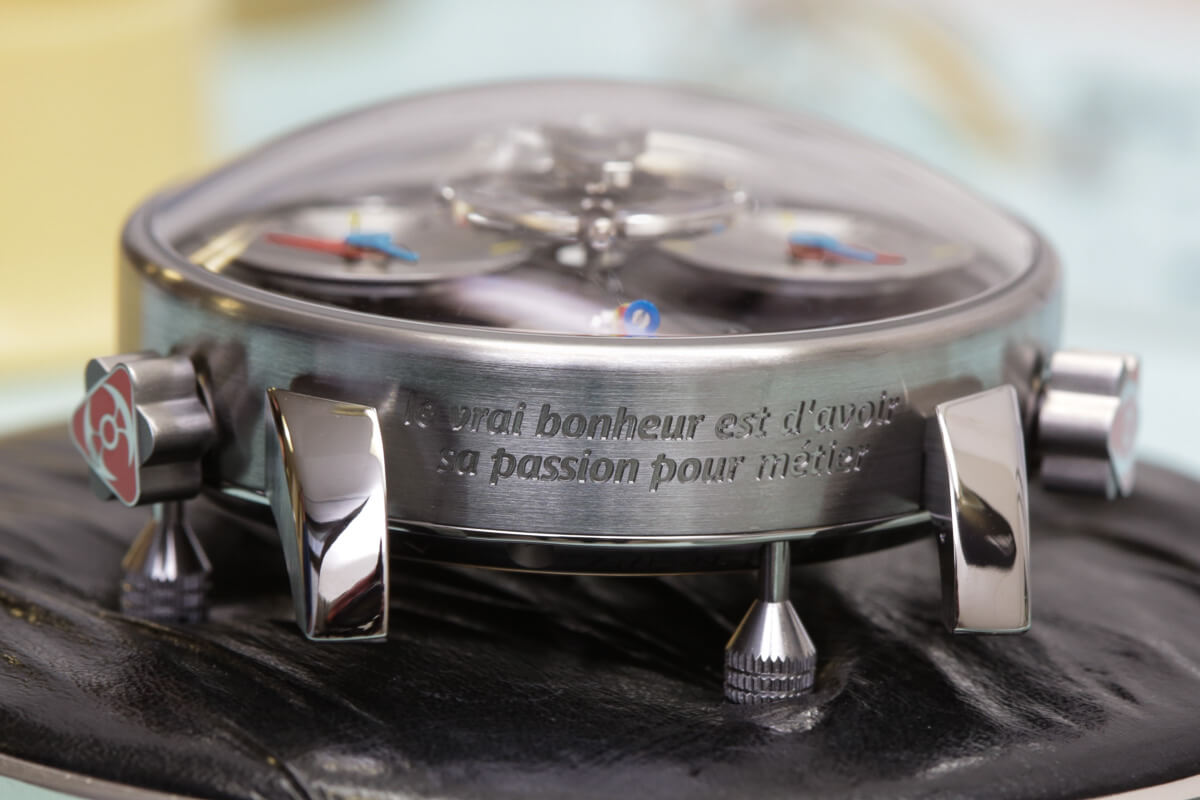
This MB&F timepiece also bears the Silberstein tagline: “le vrai bonheur est d’avoir sa passion pour métier” (“true happiness is to have passion for your work”)
Engraved in French on the case band between the lugs of Legacy Machine 1 Silberstein is a paraphrase of a quote by Stendhal that acts as Silberstein’s catch phrase: “le vrai bonheur est d’avoir sa passion pour métier,” which translates as “true happiness is to have passion for your work.”
“I think this collaboration capsule program is also very interesting for Max because it’s a way to enrich the offerings,” Silberstein continued. “When you are your own entrepreneur, it’s your own babies, and sometimes you can be blind, even if you have so many ideas.”

MB&F LM1 Silberstein in natural titanium
Silberstein certainly never runs out of ideas, but I was still curious as to why the HM2.2 and the LM1 Silberstein look so very different stylistically. And then I received the unexpected answer.

The MB&F LM1 Silberstein in (L-R) red gold with frosted dial, blackened titanium, and natural titanium
“I was a little shy with the Black Box. But not here! While this is a true MB&F piece, it is also fully an Alain Silberstein creation because you have all my color codes.”
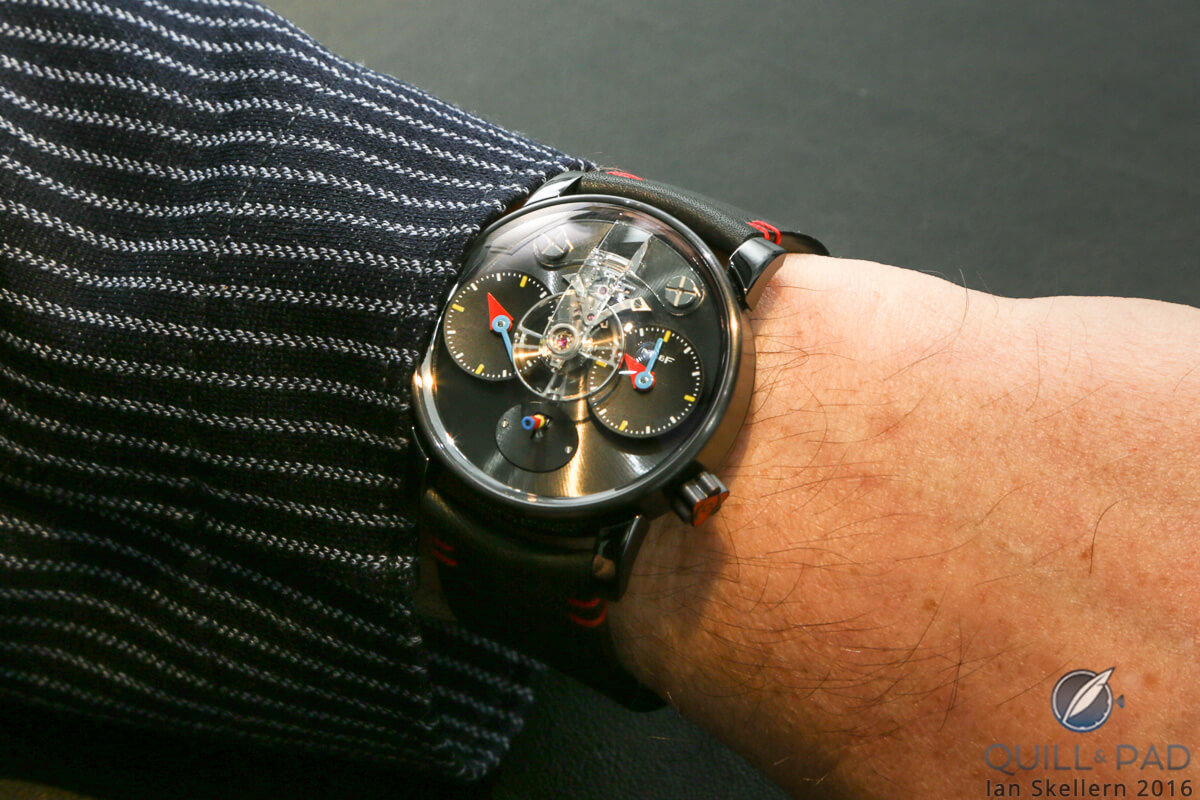
MB&F LM1 Silberstein black on the wrist of Alain Silberstein
For more information, please visit www.mbandf.com.
Quick Facts MB&F Legacy Machine Silberstein
Case: 42.5 x 17 mm, red gold, titanium, and black PVD-coated titanium
Movement: manually wound movement developed by Jean-François Mojon/Chronode and Kari Voutilainen with sapphire crystal balance bridge and 14 mm balance wheel
Functions: hours, minutes; power reserve indication, second time zone
Price: 79,000 Swiss francs (titanium), 88,000 Swiss francs (red gold) plus applicable taxes
Limitation: 12 pieces each in red gold, titanium, and black PVD-coated titanium
Trackbacks & Pingbacks
-
[…] You might also enjoy Shy No More: MB&F LM1 Silberstein. […]
-
[…] While commonly used in our everyday lives, it’s surprising that cross-slot screws are rarely featured in watches. And so they certainly jump out when MB&F presents two large polished cross slots holding the sapphire crystal tourbillon bridge of the LM1 Silberstein. […]
-
[…] You may also enjoy, Shy No More: MB&F LM1 Silberstein. […]
-
[…] turned up with a package – and what should be inside but Legacy Machine Silberstein in steel (see Shy No More: MB&F LM1 Silberstein)! This watch was my Baselworld 2016 highlight, although the PVD-coated version would be the one I […]
Leave a Reply
Want to join the discussion?Feel free to contribute!



Can you tell me. I’d like to buy a crown watch and strap for Alain Silberstein krono Bauhaus2 in bronze- pvd